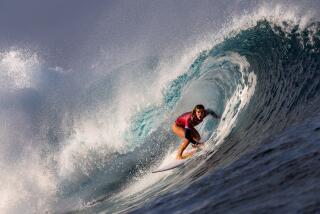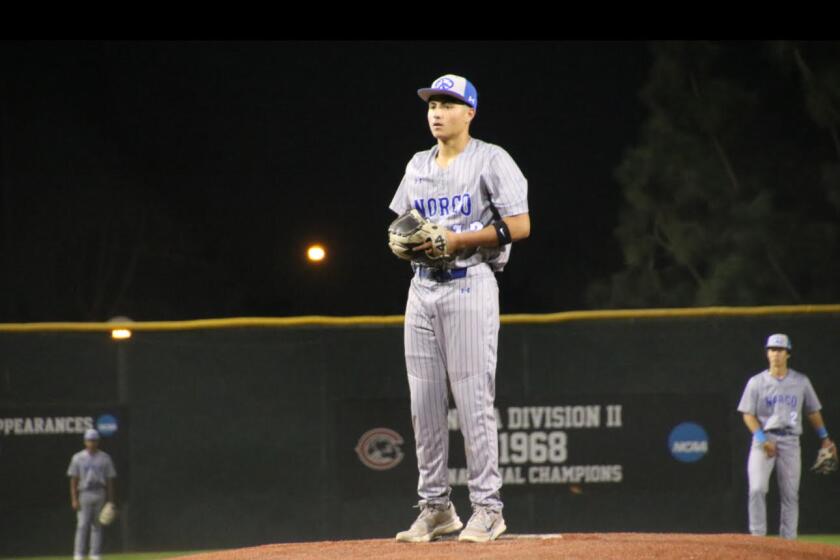Mavericks Likely Spot to Catch $50,000 Break
- Share via
It was as ominous as it was impressive, a towering wall of water so thick and powerful it had the world’s most experienced surfers paddling in circles, wondering what they were getting themselves into.
“You could have fit four buses inside that barrel, it was that big,” said Peter Mel, one of a dozen or so big-wave riders paddling out at Mavericks early Tuesday morning, on perhaps the biggest day of the biggest swell anywhere this winter. “That wave was 30 feet, easily, from the back. It was as big a wave as I have ever seen coming in my direction.”
That’s saying a lot since Mel, 28, is a longtime regular at the notorious Central California break.
Asked if the wave was ridable, Mel simply laughed, then agreed that if anyone had been in the lineup when the set rolled in, and was somehow able to pull off the 50-foot drop and the bottom turn, and emerge unscathed, he undoubtedly would be $50,000 richer come March 15.
More likely, the surfer would have been hurled to his death.
Fortunately, nobody was in position to give this thunderous breaker a try. The sets that rolled in the rest of the day were a mere 20-25 feet--about as large as even the best surfers in the world are able to handle--enabling the gang at Mavericks to compete among themselves for the grand prize in one of the richest and most controversial surfing contests ever.
The K2 Big Wave Challenge, offering $50,000 to the person who successfully rides to its completion the largest wave anywhere before March 15, and $5,000 to the photographer who captures the sequence on film, if nothing else has livened things up in the already turbulent and occasionally deadly world of big-wave surfing.
Mavericks, long a secret spot near Santa Cruz, was propelled into the limelight when Mark Foo, an expert big-wave rider from Hawaii, drowned there a few years ago after he was pitched from the lip of a wave and the massive wall of water buried him.
On Hawaii’s infamous North Shore, some have embraced K2 for giving them a chance to take a speed-run to Easy Street, while others are blasting the ski and snowboard manufacturer for making a dangerous situation even more dangerous.
“It’s a water-safety person’s worst nightmare,” Brian Keaulana, an Oahu lifeguard and big-wave surfer, told the Honolulu Star-Bulletin last month. “It puts the guys with the big ego who are not really prepared out there.”
Contest director Bill Sharp has maintained all along that the event is meant to honor the brave few who risk their lives every winter on mountainous walls of water for little or no monetary compensation while small-wave surfers rake in all the dough on the pro tour and through endorsements.
“In Hawaii, there has been some grumbling, a bit of what I call old-guard resentment,” Sharp said. “But we don’t think this will compel anyone who has no experience [in big waves] to do anything crazy. The guys who are going to be out there anyway, they think it’s a buzz to ride giant waves and they’d do it for 50 cents or 50 bucks. Now they can do it for $50,000.”
Sharp also pointed out that Hawaiian lifeguards have had little to worry about this winter because there has been a conspicuous absence of large waves on the North Shore, despite early predictions that El Nino would whip up all kinds of wild surf.
It had been quiet on the mainland as well--until last week, when swells from an Aleutian storm began pounding the California coast, much to the delight of the few dozen Mavericks regulars who have been streaking down hollowed-out 40-foot faces of 20- to 25-foot waves on and off since Jan. 13.
“There are only about 15-20 guys that really go and charge Mavericks when it’s big, guys like Jeff Clark, who’s the king, and Peter Mel, Jay Moriarty, Josh Loya, Don Curry,” said Frank Quirarte, a photographer who has been shooting almost daily from his inflatable boat.
Quirarte arrived a little late Tuesday morning, just after the monster set Mel spoke of rolled in from the west.
“It freaked them all out,” he said. “It totally stopped them. They were all just sitting there on their boards, wondering what to do.”
The biggest wave of the set broke over such a wide area that the surfers, paddling in the safety of a deep-water channel south of the break, weren’t sure how safe it was to paddle into the area where the wave usually bowls up and breaks, so they sat there a while before inching toward the lineup, with a watchful eye on the horizon.
Sets of 20-footers began pumping in, and the surfers eventually came to the conclusion that the massive set that greeted them during the 600-yard paddle out was a fluke.
Still, the adrenaline was gushing through the surfers’ veins, as it always does on a big day at Mavericks. And in the backs of every surfer’s mind was a possible $50,000 payday, which probably will be awarded to a Mavericks surfer.
“Waimea Bay is probably out of the running already,” Sharp said, “because the waves at Mavericks this past week have been bigger than anything Waimea can handle. Waimea closes out when it gets this big.”
It doesn’t matter. Big-wave riders go where the waves are.
Australian residents Ross Clarke Jones and Tony Ray, for example, were out with Mel on Tuesday and caught more than their share of waves. The monster set seemed merely to set the stage for an eventful session that lasted five hours.
The most spectacular wipeout belonged to Chris Brown, a Mavericks regular who caught air during the drop and severely injured his knee on impact, after which he was quickly sent over the falls and held under several seconds, before emerging to discover that his surfboard had snapped in two.
Brown reportedly was “stoked” merely to be alive, and to see Quirarte by his side in his boat.
The biggest wave, many agree, was a 20- to 25-footer ridden by Mel, who got dropped in on by two others, one of whom kicked out immediately. The other, Mel’s good friend Darryl “Flea” Virostko, rode the wave to its completion along with Mel.
Because Mel had position on Virostko, being closer to the break, the wave was officially his, Sharp said, and it is Mel who is the front-runner so far in the K2 Challenge.
Asked if he’d be willing to share the money with Flea--so nicknamed because when he was younger and smaller he looked like one streaking down the faces of large waves--Mel paused for a few seconds and then said, “Well, I’ll throw a good party for him.”
Asked if the contest might lead someone to get in over their heads and pay the ultimate price, Mel refused to speculate, but he did say that prospects for a big payday have changed the surfers’ approach.
“Sure, it ups the ante,” he said. “It used to be just a wave-count thing: You’d paddle out and take any wave that comes in. Now you’re more selective. You just sit and wait for the biggest wave you can catch.
“As for [people being in over their heads], most of these guys I’ve been surfing with have been out here before, but some of them are putting themselves in conditions that are out of their league. [Tuesday] was borderline, even for me, but we knew the waves could [produce the K2 Challenge winner] so we said, ‘We’re out there.’ ”
Way out there.
More to Read
Go beyond the scoreboard
Get the latest on L.A.'s teams in the daily Sports Report newsletter.
You may occasionally receive promotional content from the Los Angeles Times.










